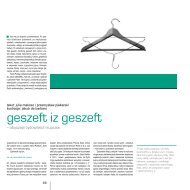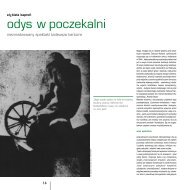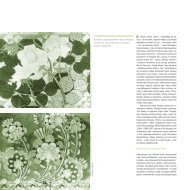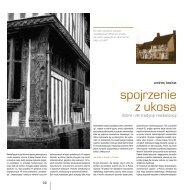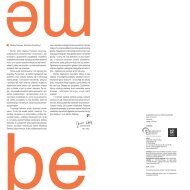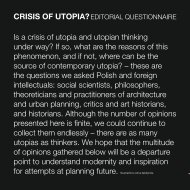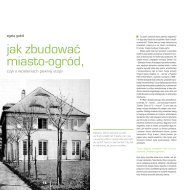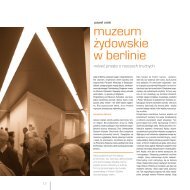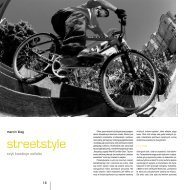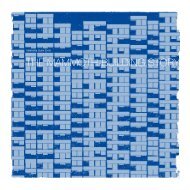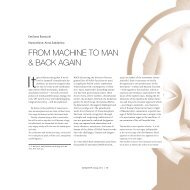ColleCtive luxury: - Autoportret
ColleCtive luxury: - Autoportret
ColleCtive luxury: - Autoportret
Create successful ePaper yourself
Turn your PDF publications into a flip-book with our unique Google optimized e-Paper software.
auspices of good morals and observation of<br />
etiquette, courtesy and taste which naturally<br />
result from social life.” 6 In Lefebvre’s<br />
reading, Fourier opposed a century of<br />
ascetism in leftists thought and conceived<br />
collective <strong>luxury</strong> as a political project.<br />
“These ideas–wrote Fourier–which appear<br />
as a calculation of <strong>luxury</strong> and superfluity,<br />
are, in fact, a theory of high politics, from<br />
which will be derived the fundamental<br />
principle of social happiness, the germ of<br />
association.” 7<br />
Lefebvre’s reading of Fourier avoids the<br />
gap between architecture and the city,<br />
which characterized much of the reception<br />
of Fourier’s work, too often read either<br />
through the design of the phalanstery,<br />
considered a rural settlement or a center<br />
of a small industrial town; 8 or through the<br />
urban designs of Fourier’s “disciples.” They<br />
6 E. Silberling, Dictionnaire de sociologie phalanstérienne:<br />
guide des oeuvres complètes de Charles Fourier (Paris: Librairie<br />
des Sciences Politiques et Sociales, 1911), p. 326.<br />
7 Ch. Fourier, Des modifications à introduire dans<br />
l’architecture des villes (Paris: Librairie Phalanstérienne,<br />
1849), p. 20.<br />
8 According to Riasanovsky, Fourier neglected the<br />
world outside the phalanx, he delighted in rural life,<br />
and he offered “no counterbalancing enthusiasm<br />
for or interest in industry, urban life, technology, or<br />
science”. However, Jonathan Beecher, Fouriers biographer,<br />
corrected this view that Fourier was attracted<br />
to urban architecture and in the 1790s has formulated<br />
some general principles concerning the ideal urban<br />
center. Fourier’s writings about the city, although not<br />
extensive, established a broad approach to urbanism<br />
which inspired his disciplined to relate these principles<br />
to the planning of Paris. See: N. Papayanis, Planning<br />
Paris before Haussmann (Baltimore: Johns Hopkins<br />
University Press, 2004), p. 171.<br />
included the polytechnicien Victor Considerant,<br />
the anonymous urbanist known as<br />
Perreymond, and the architect César Daly;<br />
all contributors to the debates about the<br />
urban development of Paris in the 1830s<br />
and 1840s.<br />
This focus of Lefebvre on the “Fourierist<br />
city” was a symptom of a rethinking of the<br />
relationship between architecture and the<br />
city, inscribed into a general revision of<br />
the architectural avant-garde of the early<br />
20 th century and functionalist urbanism.<br />
In this context, the rediscovery of Fourier<br />
sounds paradoxical because of his essential<br />
role in the self-constructed genealogy<br />
of the avant-gardes and their performative<br />
historiographies. 9 This perception<br />
of Fourier was expressed, for example,<br />
in Walter Benjamin’s stress on Fourier’s<br />
discovery of glass in the Parisian arcades<br />
as a fundamental material for the architecture<br />
to come; in Tony Garnier’s project of<br />
the industrial city which refers to Fourier<br />
by a mediation of Emil Zola’s Work; or in<br />
Siegfried Giedion’s tracing the ideas of<br />
decentralisation in modern urbanism back<br />
to Fourier and developed by the postwar<br />
authors. 10 .<br />
9 P. Tournikiotis, The Historiography of Modern Architecture<br />
(Cambridge, Mass. : MIT Press, 1999).<br />
10 See: Tony Garnier, Une cité industrielle: étude pour la<br />
construction des villes (Paris: Vincent, 1917); Émile Zola,<br />
Work (London: Chatto & Windus, 1901 [1901]); Sigfried<br />
Giedion, Space, Time and Architecture: The Growth of a New<br />
Tradition (Cambridge, MA: Harvard University Press,<br />
1970), p. 820.<br />
autoportret 2 [34] 2011 | 37<br />
Lefebvre was pursuing a very different<br />
reading of Fourier to the one inscribed into<br />
the tradition of the architectural modern<br />
movement and its association with the<br />
Keynesian welfare state. The inspiration<br />
for such reading came from Roland Barthes,<br />
Lefebvre’s close friend, and his 1970<br />
book Sade Fourier Loyola. Barthes has shown<br />
all three - the libertine, the utopian socialist,<br />
and the founder of the Jesuit order - as<br />
logothetes, that is to say as founders of language.<br />
He noticed that what is specific for<br />
Fourier’s style is that he withholds the decisive<br />
utterance of the doctrine, giving only<br />
its examples, seductions, “appetizers”; “the<br />
message of this book is the announcement<br />
of a forthcoming message”; the signified<br />
of the book is stretching out of sight – it is<br />
the book’s future. 11 Fourier is an author of<br />
procrastination. Or, in the words of Walter<br />
Benajmin, “Fourier loves preambles, cisambles,<br />
transambles, postambles, introductions,<br />
extroductions, prologues, interludes,<br />
postludes, cismediants, mediants, transmediants,<br />
intermedes, notes, appendixes”. 12<br />
The same is true of Fourier’s architectural<br />
work: Fourier stresses that the buildings he<br />
describes are intermediary stages, which<br />
proliferate and multiply. They are essentially<br />
transitory objects, not unlike the<br />
“socialist objects” which Boris Arvatov, the<br />
Soviet theorist of constructivism produc-<br />
11 R. Barthes, Sade, Fourier, Loyola (Berkeley, University<br />
of California Press, 1976 [1970]), p. 90.<br />
12 W. Benjamin, The Arcades Project (Cambridge, Mass.:<br />
Belknap Press, 1999 [1982]), p. 642.



